Teachers often recommend practicing with AP 10th Class Biology Model Papers Set 3 to enhance exam readiness.
AP SSC Biology Model Paper Set 3 with Solutions
Time : 2.00 hours
Max.Marks : 50
Instructions :
- Question paper consists of 4 sections and 17 questions.
- Internal choice is available only for Q.no.12 in section III and for all the questions in section IV.
- In the duration of 2 hours, 15 minutes of time is allotted to read the question paper.
- All answers shall be written in the answer booklet only.
- Answers shall be written neatly and legibly.
SECTION – 1
(6 × 1 = 6)
Note :
- Answer all the questions.
- Each question carries 1 mark.
Question 1.
Write the flow chart of the passage of air from nostrils to Alveoli.
Answer:
![]() → Nasal cavity → Pharynx → Larynx → Trachea → Bronchi → Bronchioles → Alveolus →
→ Nasal cavity → Pharynx → Larynx → Trachea → Bronchi → Bronchioles → Alveolus → ![]()
Question 2.
Why we feel burning sensation in throat when we vomit ?
Answer:
While vomiting peristalsis occurs in reverse direction. Then the partially digested food comes out along with HCl. So we feel burning sensation.
Question 3.
What happens if the valves of veins do not function properly ? Guess and write.
Answer:
The blood in veins cannot move up towards heart. It accumulates in veins causing swelling, inflammation and damage of veins.
![]()
Question 4.
What are the uses of tannins ?
Answer:
Tannins are used to clean the leather.
Question 5.
Which hormone is related to this experiment ?

Answer:
Auxins.
Question 6.
Observe the following table and write the phenotypic and genotypic ratios according to Mendel’s experiment.
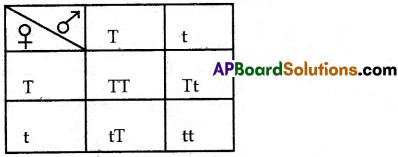
Answer:
Phenotype ratio : 3 : 1
Genotype ratio : 1 : 2 : 1
![]()
SECTION – II
(4 × 2 = 8 M)
Note :
- Answer all the questions.
- Each question carries 2 marks.
Question 7.
What happens if variations do not occur among organisms? Guess and write.
Answer:
Survival of organisms is not possible because these variations bring the favourable changes in the organism. These changes help the organism thrive under different conditions.
Question 8.
What questions you ask the doctor about the health of kidneys ?
Answer:
- What steps should be followed to keep our kidneys healthy ?
- Are there any substances which damage our kidneys ?
- What sort of food helps us keeping our kidneys in healthy condition ?
- If I suffer from kidney failure what type of treatment is needed ?
- Will consumption of more water clean our kidneys regularly ?
Question 9.
Mention any two modes of asexual reproduction with examples.
Answer:
1. Fission :
Single celled organisms split into two daughter cells that are identical to the parent cell. This
method of reproduction is called “binary fission.”
Eg : Bacteria, Euglena, Amoeba etc.
Sometimes they split into more than two and it is called multiple fission.
Eg: Plasmodium.
2. Budding : A growth on the body is called a bud. It grows nearly identical to the parent. When it is matured it gets separated from the parent and becomes independent.
Eg : Yeast, Hydra.
Question 10.
What happens if the platelets are absent in blood?
Answer:
If blood platelets are absent the person will lose the capacity of coagulation of blood. As a result injured blood vessels cannot stop bleeding. It may lead to the death of the person.
![]()
SECTION – III
(5 × 4 = 20 M)
Note :
- Answer all the questions.
- Each question carries 4 marks.
Question 11.
What are four R’s ? Explain how they help to conserve the environment.
Answer:
4R’s
R – Reduce
R- Reuse
R – Recycle
R – Recover
- Reduce : We can save water by repairing leaky taps and avoiding a shower (or) switching off unnecessary lights and fans.
- Reuse : Reuse things that you often tend to throw away, like paper and wrapping papers. This would save plants and minimise pollution.
- Recycle : There are as many types of plastic as their uses. Since each type can only be recycled with its own kind plastics need to be carefully sorted before they can be processed.
- Recover : When we cut trees to construct industries or roads for transportation, it is important to grow trees in other areas.
Question 12.
Observe the given diagram and answer the questions.

A) Write the names of parts A, B
Answer:
A. Stamen
B. Carpels
B) In which part female gamate is formed ?
Answer:
Gamete is formed in ovary
C) What is the function of part – C ?
Answer:
Sepals,these help to safe guard the buds and flowers. They also protect both flowers and fruits.
D) Is this flower an unisexual or bisexual ? Why ?
Answer:
It is a bisexual flower, because it has both stamens and carpel.
Eg. Datura.
(OR)
Draw a neatly labelled diagram of Brain.
Answer:
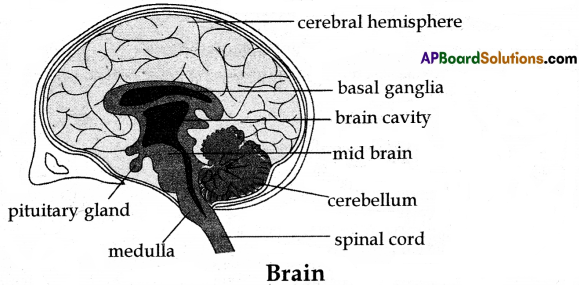
![]()
Question 13.
Observe the table and answer the questions.
| Hormones | Uses |
| Auxins | Cell elongation, differentiation of shoots and roots. |
| Cytokinins | Promote cell division, delaying the ageing in leaves, opening of stomata. |
| Gibberellins | Germination of seeds, sprouting of buds; elongation of stem; stimulation of flowering; development of seedless fruits, breaking the dormancy in seeds and buds. |
| Abscisic acid | Closing of stomata; seed dormancy, promoting ageing of leaves. |
| Ethylene | Ripening of fruit. |
A) Which plant hormone is responsible for the ripening of fruits ?
Answer:
Ethylene
B) Which hormone promotes seed dormancy ?
Answer:
Abscicic acid
C) What are the uses of cytokinins in plants?
Answer:
Promote cell division, delaying the ageing in leaves, opening of stomata.
D) What are the functions of Auxins in plants ?
Answer:
Cell elongation and differentiation of shoots and roots.
Question 14.
Explain the process of sex determination in human beings.
Answer:
- Each human cell contains 23 pairs (46) of chromosomes.
- Out of 23 pairs 22 pairs of chromosomes are called autosomes. Remaining one pair is called allosomes (sex chromosomes).
- There are two types of sex chromosomes one is ‘X’ and the other is ‘Y’. These two chrom-osomes determine the sex of an individual.
- Females have two ‘X’ chromosomes in their cells (XX)
- Males have one ‘X’ and one ‘Y’ chromosome in their cells (XY)
- If the sperm carries ‘X’ – chromosome and fertilizes with ovum, the resultant baby will have XX condition. So the baby will be a girl.
- If the sperm carries’ Y’ chromosome and fertilizes with ovum; the resultant baby will have XY condition. So the baby will be a boy.
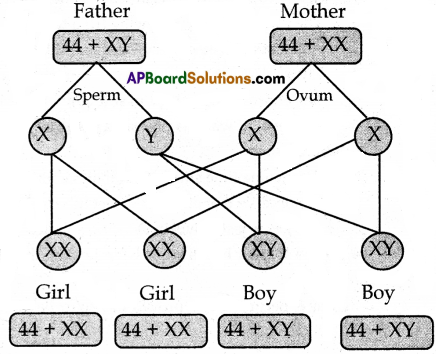
Question 15.
What is peristaltic movement ? Compare the similarity of bolus movement in oesophagus with cycle tube and potato experiment which you have conducted in school.
Answer:
Definition:
The movement of the soft food mixed with saliva passing through oesophagus or food pipe by wave like movements is called peristaltic movements.
- The wall of the food pipe is lined with mucus secretion as the oil that lubricated cycle tube in the experiment.
- Mucus lubricates and protects the oesophageal walls from damage.
- This helps the food bolus to slide down easily just as the oil that move the potatoes in the cycle tube.
- Contraction of circular muscles in narrowing of the food pipe as we squeeze the cycle tube above the potato for downward movement.
- Contraction of the longitudinal muscles in front of the bolus widen the tube as widening the cycle tube in front of the potato.
![]()
SECTION – IV
(2 × 8 = 16 M)
Note :
- Answer all the questions.
- Each question carries 8 marks.
- Each question has internal choice.
Question 16.
A) How would you demonstrate that green plants release oxygen when exposed to light ?
Answer:
Aim :
To prove that oxygen is released during photosynthesis.
Apparatus : Hydrilla twigs, test tube, funnel, glowing splinter, beaker, water.
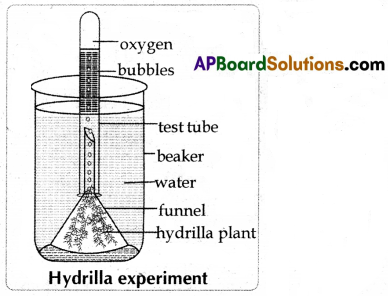
Experiment:
- A few twigs of hydrilla are taken and inserted into the funnel.
- The funnel along with the hydrilla twigs is placed in a beaker filled with water.
- A test tube is filled with water and it is inverted over the funnel.
- Ensured that the level of water in the beaker is above the level of stem of the inverted funnel.
- The entire set up is kept in sunlight for nearly 2 – 3 hours.
- The level of water is observed in the test tube.
Observation:
- After some time small gas bubbles come out of the leaves of hydrilla.
- We observe that air fills the test tube by lowering the water level.
- The gas is tested with a glowing splinter.
- The splinter bums brightly, indicating that the gas accumulated is oxygen.
Inference:
By this experiment, it is proved that hydrilla plant performed photosynthesis and released oxygen.
![]()
(OR)
B) How can you prove that water is transported through the xylem ?
Answer:
Aim :
To show root pressure in the plants.
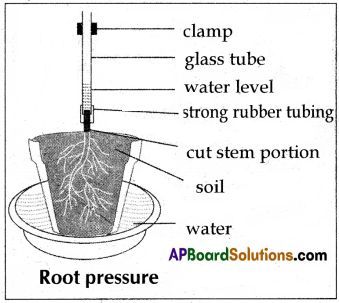
Apparatus :
Potted plant, glass tube, clamp, rubber tube, tub.
Procedure:
- A selected potted plant is watered regularly.
- A cut is made on the stem of the potted plants 1 cm above the ground level.
- A glass tube is connected by means of a strong rubber tube. The size of glass tube should be equal to the size of the stem.
- Stem is tightly bound with tube so that water cannot escape from the tube.
- Water is poured in the glass tube until water level is seen above the rubber tube. The level of water is marked (M1)in the tube.
- Whole experiment is kept undisturbed for 2 to 3 hours.
- Water level in the tube is observed and marked (M2).
Observation:
Water level increases from M1 to M2.
Inference:
Pressure in the xylem vessels made the movement of water from root hair to xylem vessels through the root cells.
![]()
Question 17.
A) What are fat soluble vitamins ? Explain it.
Answer:
| Vitamins | Deficiency diseases | Resources |
| Vit – A | Night blindness, Myopia, dry eyes, scaly skin liver oil, Shark liver oil, Milk | Leafy vegetables, Carrot, Tomato, Pumpkin, Fish, Eggs, Liver, Cod |
| Vit – D | Rickets | Liver, Egg, Butter, Morning sun rays. |
| Vit – E | Fertility disorders | Fruits, Vegetables, Sprouts, Meat, Egg, Sunflower oil. |
| Vit – K | Blood clotting doesn’t occur | Green leafy vegetables, Milk, Meat |
(OR)
B) What do you understand by the term natural selection. Write Darwin’s theory of evolution.
Answer:
Natural Selection :
It means that the nature only selects (or) decides which organisms should survive (or) perish in nature.
Darwin’s theory of evolution:
- Any group of population of an organism develops variations. Variations which are useful to an individual are retained, while those which are not useful are lost.
- Each species tend to produce large number of offsprings. They compete in this struggle for existence, only the fittest can survive (survival of the fittest).
- The offsprings of survivor inherit the useful variations and the same process happens with every new generation until the variation becomes a common feature.
- Over a long period of time, each species of organism can accumulate so many changes that it becomes a new species.
- Evolution is a slow and continuous process.